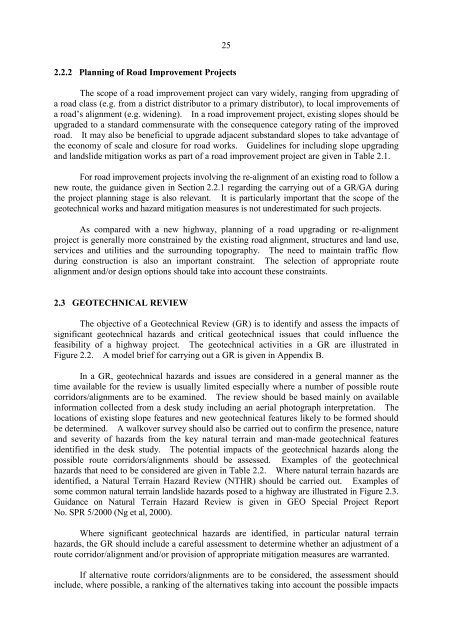Highway Slope Manual
Highway Slope Manual
Highway Slope Manual
Create successful ePaper yourself
Turn your PDF publications into a flip-book with our unique Google optimized e-Paper software.
25<br />
2.2.2 Planning of Road Improvement Projects<br />
The scope of a road improvement project can vary widely, ranging from upgrading of<br />
a road class (e.g. from a district distributor to a primary distributor), to local improvements of<br />
a road's alignment (e.g. widening). In a road improvement project, existing slopes should be<br />
upgraded to a standard commensurate with the consequence category rating of the improved<br />
road. It may also be beneficial to upgrade adjacent substandard slopes to take advantage of<br />
the economy of scale and closure for road works. Guidelines for including slope upgrading<br />
and landslide mitigation works as part of a road improvement project are given in Table 2.1.<br />
For road improvement projects involving the re-alignment of an existing road to follow a<br />
new route, the guidance given in Section 2.2.1 regarding the carrying out of a GR/GA during<br />
the project planning stage is also relevant. It is particularly important that the scope of the<br />
geotechnical works and hazard mitigation measures is not underestimated for such projects.<br />
As compared with a new highway, planning of a road upgrading or re-alignment<br />
project is generally more constrained by the existing road alignment, structures and land use,<br />
services and utilities and the surrounding topography. The need to maintain traffic flow<br />
during construction is also an important constraint. The selection of appropriate route<br />
alignment and/or design options should take into account these constraints.<br />
2.3 GEOTECHNICAL REVIEW<br />
The objective of a Geotechnical Review (GR) is to identify and assess the impacts of<br />
significant geotechnical hazards and critical geotechnical issues that could influence the<br />
feasibility of a highway project. The geotechnical activities in a GR are illustrated in<br />
Figure 2.2. A model brief for carrying out a GR is given in Appendix B.<br />
In a GR, geotechnical hazards and issues are considered in a general manner as the<br />
time available for the review is usually limited especially where a number of possible route<br />
corridors/alignments are to be examined. The review should be based mainly on available<br />
information collected from a desk study including an aerial photograph interpretation. The<br />
locations of existing slope features and new geotechnical features likely to be formed should<br />
be determined. A walkover survey should also be carried out to confirm the presence, nature<br />
and severity of hazards from the key natural terrain and man-made geotechnical features<br />
identified in the desk study. The potential impacts of the geotechnical hazards along the<br />
possible route corridors/alignments should be assessed. Examples of the geotechnical<br />
hazards that need to be considered are given in Table 2.2. Where natural terrain hazards are<br />
identified, a Natural Terrain Hazard Review (NTHR) should be carried out. Examples of<br />
some common natural terrain landslide hazards posed to a highway are illustrated in Figure 2.3.<br />
Guidance on Natural Terrain Hazard Review is given in GEO Special Project Report<br />
No. SPR 5/2000 (Ng et al, 2000).<br />
Where significant geotechnical hazards are identified, in particular natural terrain<br />
hazards, the GR should include a careful assessment to determine whether an adjustment of a<br />
route corridor/alignment and/or provision of appropriate mitigation measures are warranted.<br />
If alternative route corridors/alignments are to be considered, the assessment should<br />
include, where possible, a ranking of the alternatives taking into account the possible impacts

















